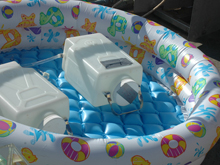
The phytoplankton experiment would not be possible without the aid of an inflatable baby pool, one of the many unusual items onboard the Russian research vessel Professor Khromov. Click image for larger view and image credit.
The Things They Hauled
September 9, 2009
Christine Patrick
Public Affairs Specialist
NOAA's Office of Ocean Exploration and Research
You're going to sea in the Arctic for 30 days: what to pack? Should you bring your own personal coffee maker? Can you do without your beloved lab chair? Your favorite earrings? Should the baby pool come with you, along with your bathing suit? All of these things are onboard for the RUSALCA expedition, but only one doesn't belong. On Day 2, while learning how to get into my survival (or "Gumby") suit, I discovered that jewelry and thick, heavy neoprene do not mix.
It's an interesting problem to know you need enough stuff for a month away from home, while also knowing your space onboard will be very limited. There are costs to bringing both too much and too little.
It turns out that even what to pack your stuff in matters. Rolling suitcases are a dime a dozen in every airport, but it's only the novice who brings one onto a ship. Why? Because you can't fold them up and store them the way you can with a big duffel bag. My suitcase is now taking up precious floor space in my cabin. Meanwhile, the most experienced explorers have brought additional duffel bags, in case they need them on the way back.
Of course, it's obvious you need winter clothes. Although this is late summer in the Arctic, you still need a down jacket, wool socks, a hat, gloves, and long underwear. In your cabin, it's important to have seasickness medicine and earplugs.
If you're part of the science team, you also need specialized clothing for your work. On deck, most people are wearing Mustang suits, named for the manufacturer (although Stearns also makes them). Mustang suits are waterproof, warm, and lightweight — a mariner's version of a mechanic's jumpsuit — and also serve as personal flotation devices. Steel-toed rubber boots are also requisite.
Science teams have more to think about than clothes: they need to recreate their labs. Plywood, power drills, and screws are necessary for building workbenches. And you simply must have a baby pool for the phytoplankton experiment. Favorite desk chair? Hours upon hours spent hunched over a microscope can be sustained only with the help of an adequately supportive chair.
One thing you don't have to worry about on this mission is bringing towels, bedding, or food: those are all provided by Heritage Expeditions, which operates the Russian research vessel Professor Khromov. The science crew routinely tells me how lucky I am to be on a vessel with four-star food — the best they've ever had on a research ship.
Someone like me, who has never spent so much as an overnight on a ship, at least knows there's no need for a swimsuit in these icy regions. Wrong again! This ship has a sauna quietly tucked away on the lower deck: a reward for those with better judgment.















